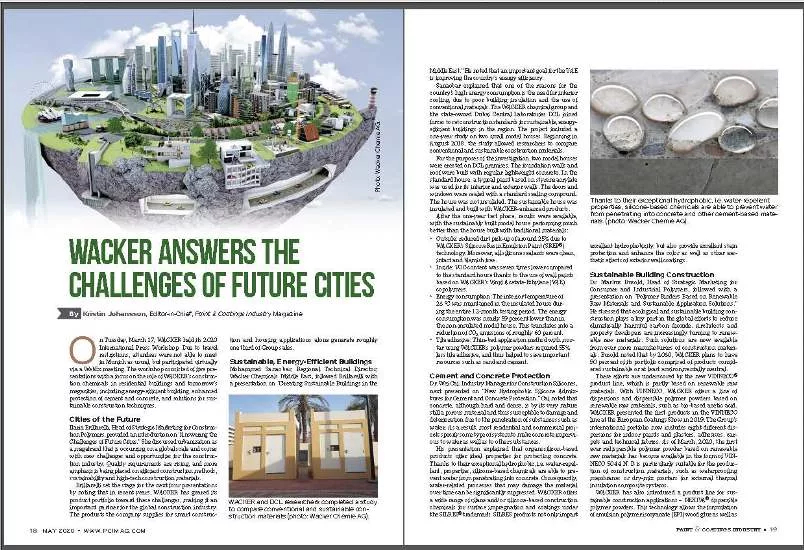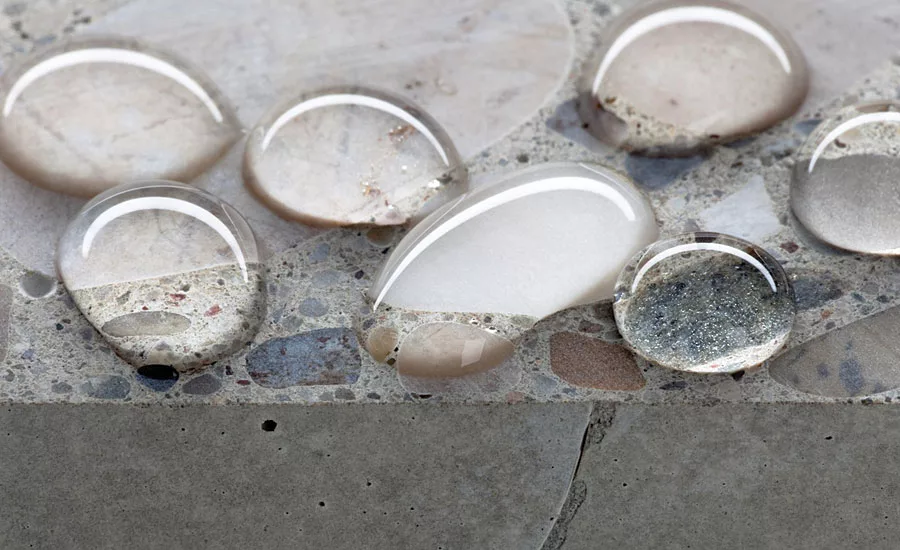WACKER Answers the Challenges of Future Cities

Prefer the magazine experience? Subscribe to our digital edition here.



On Tuesday, March 17, WACKER held its 2020 International Press Workshop. Due to travel restrictions, attendees were not able to meet in Munich as usual, but participated virtually via a WebEx meeting. The workshop consisted of five presentations with a focus on the role of WACKER’s construction chemicals in residential buildings and tomorrow’s megacities, including energy-efficient building, enhanced protection of cement and concrete, and solutions for sustainable construction techniques.
Cities of the Future
Ilaria Brillarelli, Head of Strategic Marketing for Construction Polymers, provided an introduction on “Answering the Challenges of Future Cities.” She discussed urbanization as a megatrend that is occurring on a global scale and comes with new challenges and opportunities for the construction industry. Quality requirements are rising, and more emphasis is being placed on efficient construction methods, sustainability and high-tech construction materials.
Brillarelli set the stage for the next four presentations by noting that in recent years, WACKER has geared its product portfolio toward these challenges, making it an important partner for the global construction industry. The products the company supplies for smart construction and housing applications alone generate roughly one third of Group sales.
Sustainable, Energy-Efficient Buildings
Mohammed Sanaobar, Regional Technical Director, Wacker Chemicals Middle East, followed Brillarelli with a presentation on “Creating Sustainable Buildings in the Middle East.” He noted that an important goal for the UAE is improving the country’s energy efficiency.
Sanaobar explained that one of the reasons for the country’s high energy consumption is the need for interior cooling, due to poor building insulation and the use of conventional materials. The WACKER chemical group and the state-owned Dubai Central Laboratories DCL joined forces to set construction standards for sustainable, energy-efficient buildings in the region. The project included a one-year study on two small model houses. Beginning in August 2018, the study allowed researchers to compare conventional and sustainable construction materials.
For the purposes of the investigation, two model houses were erected on DCL premises. The foundation walls and roof were built with regular lightweight concrete. In the standard house, a typical paint based on styrene acrylate was used for its interior and exterior walls. The doors and windows were sealed with a standard sealing compound. The house was not insulated. The sustainable house was insulated and built with WACKER-enhanced products.
After the one-year test phase, results were available, with the sustainably built model house performing much better than the house built with traditional materials:
- Outside: reduced dirt pick-up of around 25% due to WACKER’s Silicone Resin Emulsion Paint (SREP®) technology. Moreover, all silicone sealants were clean, intact and blemish free.
- Inside: VOC content was seven times lower compared to the standard house thanks to the use of wall paints based on WACKER’s Vinyl Acetate-Ethylene (VAE) copolymers.
- Energy consumption: The interior temperature of 23 °C was maintained in the insulated house during the entire 12-month testing period. The energy consumption was nearly 59 percent lower than in the non-insulated model house. This translates into a reduction of CO2 emissions of roughly 60 percent.
- Tile adhesive: Thin-bed application method with mortar using WACKER’s polymer powders required 55% less tile adhesive, and thus helped to save important resources such as sand and cement.
Cement and Concrete Protection
Dr. Wei Cai, Industry Manager for Construction Silicones, next presented on “New Hydrophobic Silicone Admixtures for Cement and Concrete Protection.” Cai noted that concrete, although hard and dense, is by its very nature still a porous material and thus susceptible to damage and deterioration due to the penetration of substances such as water. As a result, most residential and commercial projects specify some type of system to make concrete impervious to water as well as to other substances.
His presentation explained that organosilicon-based products offer ideal properties for protecting concrete. Thanks to their exceptional hydrophobic, i.e. water-repellent, properties, silicone-based chemicals are able to prevent water from penetrating into concrete. Consequently, water-related processes that may damage the material over time can be significantly suppressed. WACKER offers a wide range of silane and/or silicone-based construction chemicals for surface impregnation and coatings under the SILRES® trademark. SILRES products not only impart excellent hydrophobicity, but also provide excellent stain protection and enhance the color as well as other aesthetic effects of exterior wall coatings.
Sustainable Building Construction
Dr. Markus Busold, Head of Strategic Marketing for Consumer and Industrial Polymers, followed with a presentation on “Polymer Binders Based on Renewable Raw Materials and Sustainable Application Solutions.” He stressed that ecological and sustainable building construction plays a key part in the global efforts to reduce climatically harmful carbon dioxide. Architects and property developers are increasingly turning to renewable raw materials. Such solutions are now available from ever more manufacturers of construction materials. Busold noted that by 2030, WACKER plans to have 90 percent of its portfolio comprised of products considered sustainable or at least environmentally neutral.
These efforts are underscored by the new VINNECO® product line, which is partly based on renewable raw materials. With VINNECO, WACKER offers a line of dispersions and dispersible polymer powders based on renewable raw materials, such as bio-based acetic acid. WACKER presented the first products in the VINNECO line at the European Coatings Show in 2019. The Group’s international portfolio now includes eight different dispersions for indoor paints and plasters, adhesives, carpets and technical fabrics. As of March, 2020, the first ever redispersible polymer powder based on renewable raw materials has become available in the form of VINNECO 5044 N. It is particularly suitable for the production of construction materials, such as waterproofing membranes or dry-mix mortars for external thermal insulation composite systems.
WACKER has also introduced a product line for sustainable construction applications - NEXIVA® dispersible polymer powders. This technology allows the formulation of emulsion polymer isocyanate (EPI) wood glue as well as wall paints in powder form, among other potential applications. The dispersible polymer powder solution does not require the use of biocides, which is very common in liquid wall paints. These paints are waterborne and therefore require the use of biocides to prevent the growth of bacteria and other microbes. However, as biocides can trigger allergic reactions in some people, NEXIVA allows manufacturers to produce interior wall paints in powder form, which do not require the addition of biocides. The powder paint is essentially a concentrate, which professional painters and do-it-yourselfers can prepare as a liquid paint or wood glue in precise amounts as required, simply by adding water. These new powder solutions are also easier to transport and store than traditional dispersion paints or EPI wood glues.
Modular Construction
Christophe Berset, Strategic Marketing Manager for Construction Polymers, and Dr. Arndt Schlosser, Head of Construction Sealants and Adhesives for WACKER Silicones, wrapped up the day with a presentation on “Modular Construction – WACKER Solutions for Increased Quality and Productivity.”
They stated that demand for affordable housing is growing – especially in cities. The rise in construction costs, however, has led to a shortage of new or existing buildings in the affordable and mid-range price brackets. Modular construction is one solution to this problem and therefore one of the major trends in the industry.
Assembling elements has become a daily routine at many construction sites. But this involves significant challenges for contractors. Transporting the finished units produces an enormous amount of vibration. WACKER’s polymer binders lend tile adhesives, self-leveling flooring compounds, waterproofing membranes, ETICS (External Thermal Insulation Composite System) and composite materials a degree of flexibility needed to cope with the mechanical stress during delivery and assembly.
Silicone sealants and hybrid polymers also play an important role in modular building in that they deliver a permanent bond for joints, walls, doors and windows. They are used for indoor as well as outdoor sealing purposes such as connection and expansion joints, weather sealing, sanitary and other specialized sealing purposes. WACKER offers a wide range of one-component silicone sealants for the construction industry. They provide outstanding adhesion and flexibility, excellent UV and chemical resistance and are available in several curing systems.
Since 2006 the company has also been offering specialist, silane-terminated hybrid polymers for the highest demands in the adhesives and sealants market. These have some exceptional properties: they can be formulated without tin, enable the production of crystal-clear formulations, cure rapidly, and their low viscosity makes processing easy. Traditional applications of these hybrids include wood-flooring adhesives, assembly adhesives, elastic sealants and water-proofing membranes, for example, for flat roofs.
Berset and Schlosser concluded with a discussion on 3D printing, something experts consider as one of the key technologies for modular construction. WACKER and the Technical University of Munich are working together to optimize how polymers can increase the printed material’s durability and mechanical properties.
Although I was disappointed to not be able to travel to Munich with the other journalists and visit the WACKER headquarters, I was glad to participate in the online workshop. I thoroughly enjoyed each presentation, and was impressed with all of the newest technology WACKER has developed for the megacities of tomorrow. I look forward to hopefully attending in person next year!
Looking for a reprint of this article?
From high-res PDFs to custom plaques, order your copy today!








